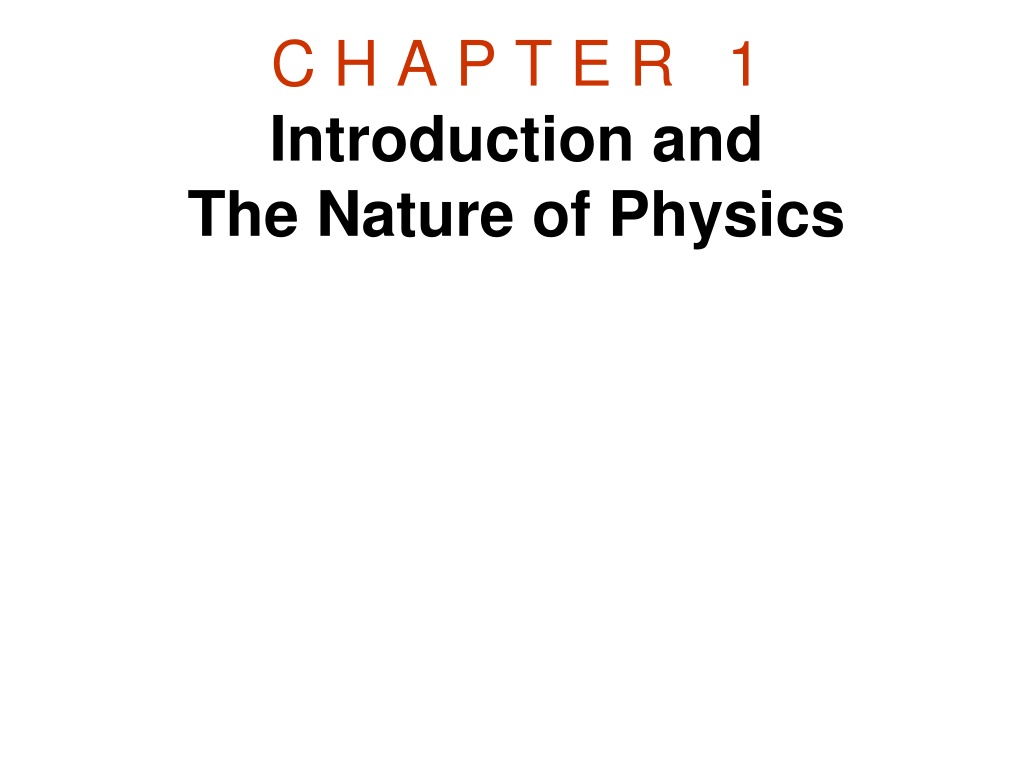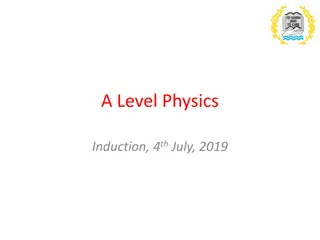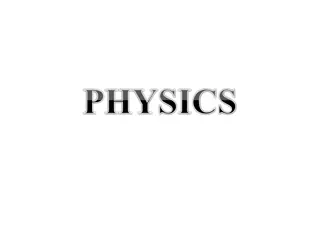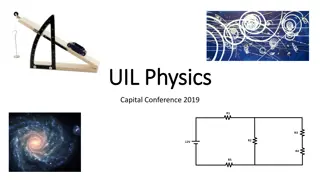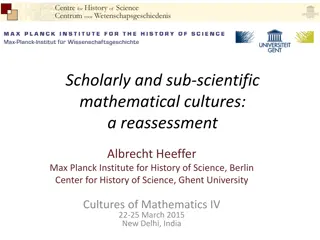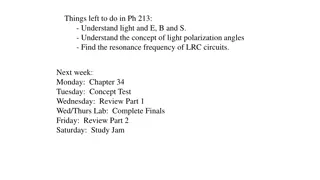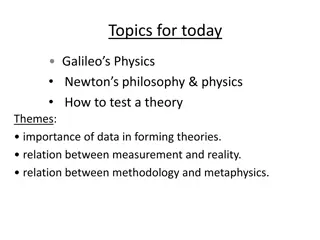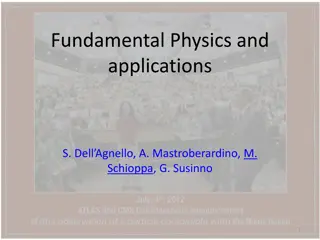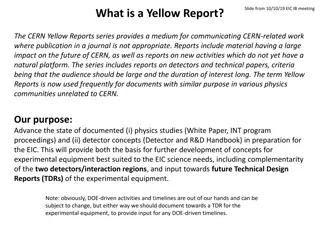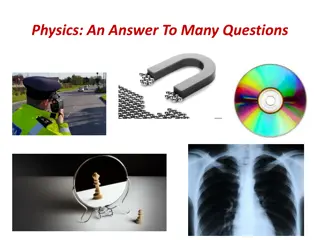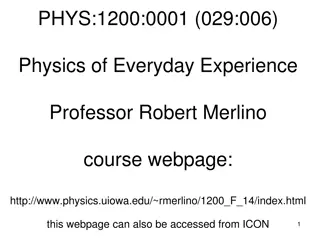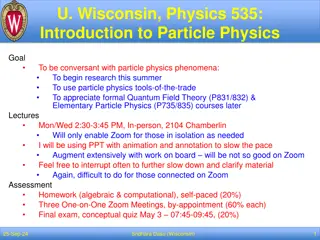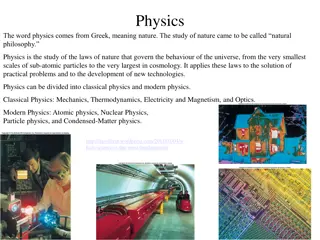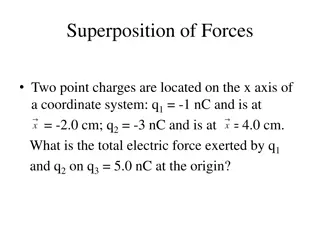The Nature of Physics and Its Sub-Fields
Physics, derived from the Greek word for nature, is the study of fundamental laws governing matter's behavior and structure. It covers various sub-fields including Mechanics, Electricity & Magnetism, and Modern Physics like Relativistic Quantum Mechanics. Through the historical progression from Aristotle to Einstein, Physics has evolved from natural philosophy to a precise science. Explore the principles, units, significant figures, approximations, and the scientific method.
Download Presentation

Please find below an Image/Link to download the presentation.
The content on the website is provided AS IS for your information and personal use only. It may not be sold, licensed, or shared on other websites without obtaining consent from the author.If you encounter any issues during the download, it is possible that the publisher has removed the file from their server.
You are allowed to download the files provided on this website for personal or commercial use, subject to the condition that they are used lawfully. All files are the property of their respective owners.
The content on the website is provided AS IS for your information and personal use only. It may not be sold, licensed, or shared on other websites without obtaining consent from the author.
E N D
Presentation Transcript
C H A P T E R 1 Introduction and The Nature of Physics
Chapter Outline 1.1 Physics: An Introduction Explain the difference between a principle and a law. Explain the difference between a model and a theory. 1.2 Physical Quantities and Units Perform unit conversions both in the SI and English units. Explain the most common prefixes in the SI units and be able to write them in scientific notation. 1.3 Accuracy, Precision, and Significant Figures Determine the appropriate number of significant figures in both addition and subtraction, as well as multiplication and division calculations. Calculate the percent uncertainty of a measurement. 1.4 Approximation Make reasonable approximations based on given data.
The Nature of Physics The word physics comes from Greek, meaning nature. The study of nature came to be called natural philosophy. Physics is the study of the fundamental laws of nature. Physics deals with the behavior and structure of matter. Physics is very fundamental and the most basic of the sciences. Physics can predict how nature will behave in one situation on the basis of experimental data obtained in another situation.
Sub-Fields of Physics Introductory physics is divided into the following sub-fields: Mechanics (Chapters 1-12) Thermal physics (Chapters 13-15) Wave motion and sound (Chapters 16-17) Electricity and magnetism (Chapters 18-24) Light and optics (Chapters 25-27) Modern physics (Chapters 28-34)
Relativistic Quantum Mechanics Modern physics: relativity (very fast) and quantum mechanics (very small). Relativity must be used whenever an object is traveling at greater than about 1% of the speed of light or experiences a strong gravitational field such as that near the Sun. Quantum mechanics must be used for objects smaller than can be seen with a microscope. The combination of these two theories is relativistic quantum mechanics, and it describes the behavior of small objects traveling at high speeds or experiencing a strong gravitational field. Relativistic quantum mechanics is the best universally applicable theory we have.
Historical Development Models, Theories, and Laws The Scientific Method The Evolution of Natural Philosophy into Modern Physics Aristotle (384 322 B.C.) Galileo Galilei (1564 1642) Isaac Newton (1642 1727) Niels Bohr (1885 1962) Max Planck (1858-1947) Albert Einstein (1879 1955)
Units of Measurement System SI CGS BE/USC Length meter (m) centimeter (cm) foot (ft) Mass kilogram (kg) gram (g) slug (sl) Time second (s) second (s) second (s) SI stands for the French phrase "Le Systeme International d'Unitus." CGS - centimeter (cm), gram (g), and second. BE/USC - British Engineering/US Customary. https://www.nist.gov/si-redefinition
Base Quantities and Units: There are 7 of them Unit Physical Quantity Name Symbol Time second s Length meter m Mass kilogram kg Electric current ampere A Temperature kelvin K Amount of substance Luminous intensity mole mol candela cd Units named after people are capitalized.
https:// www.ni st.gov/s i- redefini tion/kil ogram- focus- history
2019 SI Redefinition https://www.reddit.com/r/coolguides/comments/a83k62/the_international_system_of_units_card/ https://www.nist.gov/si-redefinition/meet-constants
https://www.nist.gov/si-redefinition/meet-constants The below graphic shows the seven base SI units and the constants used to define them. Click on each of the SI units (outer boxes) to see which constants (inner boxes) define them.
Accuracy and Precision Accuracy is how close a measurement is to the correct value for that measurement. The precision of a measurement system is refers to how close the agreement is between repeated measurements. Low precision and high accuracy High precision and low accuracy
Uncertainties in Calculations Adding or Subtraction: add the uncertainties Multiplication or Division: add the percent uncertainties
Significant Figures Expressing the significant figures: In Calculations: For multiplication and division: The result should have the same number of significant figures as the quantity having the least significant figures entering into the calculation. For addition and subtraction: The answer can contain no more decimal places than the least precise (decimals) measurement. In this class you will always express numbers with more than the minimum significant figures, unless asked specifically for a particular problem/question.
Approximation On many occasions, physicists, other scientists, and engineers need to make approximations or guesstimates for a particular quantity. These approximations allow us to rule out certain scenarios or unrealistic numbers. Approximations also allow us to challenge others and guide us in our approaches to our scientific world.
